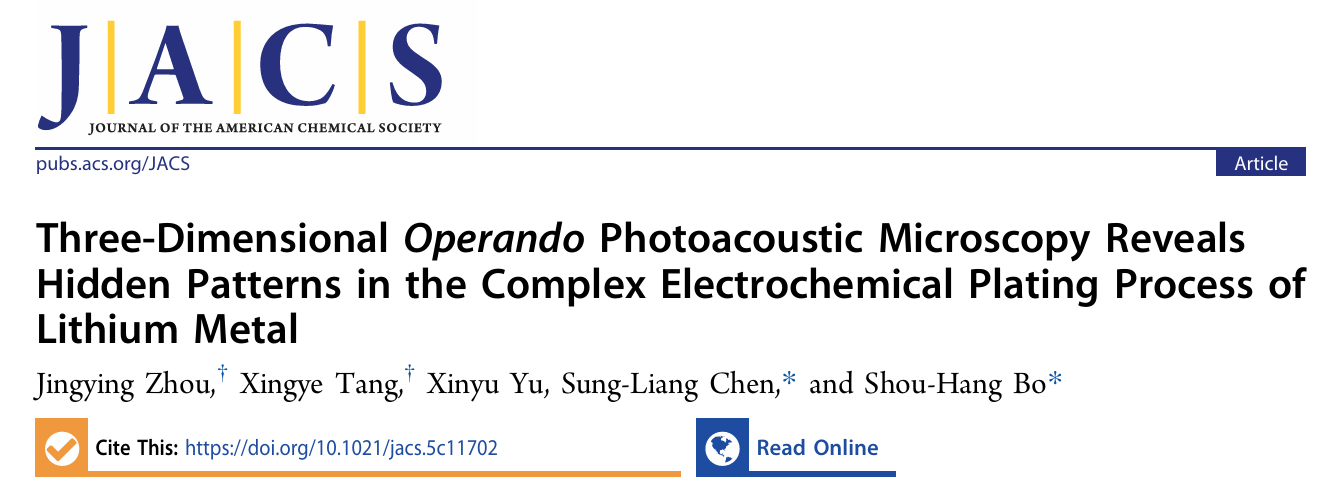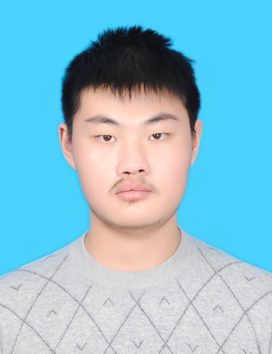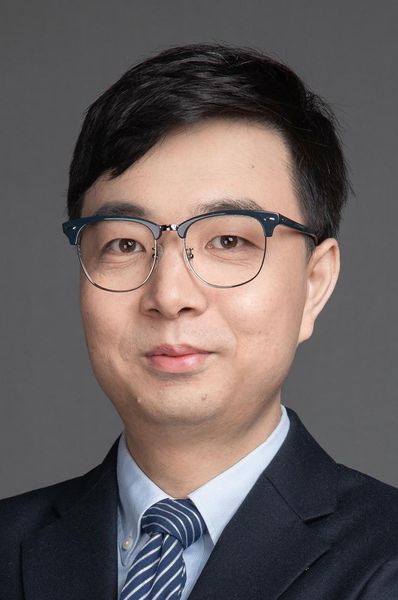GIFT Professor Shou-Hang Bo Publishes in JACS: Innovative 3D Operando Imaging Quantifies Microscopic Lithium Plating Behavior
On October 31, 2025, an interdisciplinary research team led by GIFT Professor Shou-Hang Bo and Professor Sung-Liang Chen from the SJTU Global College published a paper titled "Three-Dimensional Operando Photoacoustic Microscopy Reveals Hidden Patterns in the Complex Electrochemical Plating Process of Lithium Metal" in the Journal of the American Chemical Society (JACS). The research reveals three distinct patterns in the complex electrochemical plating of lithium metal using 3D operando photoacoustic microscopy, providing a mechanistic explanation for uneven lithium plating and lithium-dendrite formation, thereby advancing the development of dendrite mitigation strategies. Furthermore, the study provides rich datasets that can support artificial intelligence-driven diagnostics for lithium-metal batteries, optimizing the assessment for lithium-metal anode safety. Professor Shou-Hang Bo from the Global Institute of Future Technology and Professor Sung-Liang Chen from the SJTU Global College are the corresponding authors. Jingying Zhou (a PhD candidate from the GIFT Future Battery Research Center and the SJTU Global College) and Xingye Tang (a PhD candidate from the SJTU Global College) are the co-first authors. Xinyu Yu, a PhD candidate from the GIFT Future Battery Research Center and the SJTU Global College also contributed to this paper. This research was supported by the National Natural Science Foundation of China Excellent Young Scientists Fund and the Ministry of Science and Technology's Key Research & Development Program.


Lithium-metal anodes are promising for building high-energy-density batteries due to their extremely high theoretical specific capacity. However, the electrochemical plating process of lithium metal is nonuniform and complex, potentially leading to short circuits and capacity degradation in lithium metal batteries. The high chemical reactivity and low electron density of lithium metal make samples prone to oxidation and result in poor imaging. Existing imaging tools can only capture small fractions of this complex process, thereby missing the comprehensive, large-scale insights to lithium structural information with high-resolution details-much like seeing just the tip of the iceberg-thus hindering the elucidation of the mechanisms governing lithium growth. Imaging methods at different spatial scales reveal differing lithium metal growth behaviors, which have been attributed to various mechanisms including surface diffusion of lithium atoms, lithium crystal orientation, space charge layer formation, and the diffusivity of the solid-electrolyte interphase (SEI). However, a comprehensive and unified explanation remains lacking. The development of advanced imaging tools is essential to fully elucidate the complex dynamics of lithium plating.
To address this challenge, the research team developed a fast photoacoustic microscopy (PAM) system using micro-electromechanical systems (MEMS) to reveal the hidden patterns during lithium plating. Utilizing the miniaturization and rapid scanning capabilities of MEMS, the system can achieve swift imaging and quantitatively track the 3D evolution of lithium metal within a millimeter-scale field of view, enabling operando monitoring of the lithium-plating process.
This system can quantitatively analyze the microstructural differences between areas of lithium protrusion formation and uniform deposition. It is revealed that all the patterns started from a diffusion-controlled process while subsequently diverging into explosive, steady, and diminishing patterns. The study further analyzed the correlation between different growth patterns (lithium height as a function of time) and morphologies (lithium height as a function of space). The explosive pattern resulted in lithium protrusion, whereas the steady pattern corresponded to a relatively uniform morphology. The diminishing pattern may result from noncompact lithium metal with structural instability. The study tentatively attributes these observations to spatially varying SEI diffusivities, and it supports further investigation into strategies for mitigating risks in lithium-metal batteries. Additionally, this work can provide a wealth of datasets to enhance artificial-intelligence-driven diagnostics, advancing the assessment and improvement of lithium-metal anode safety.
Paper link:
https://doi.org/10.1021/jacs.5c11702
Author Profiles

Jingying Zhou
Ph.D. candidate at the GIFT Future Battery Research Center, and the SJTU Global College. Research area: operando characterization of physicochemical fields in high-energy-density batteries.

Xingye Tang
Ph.D. candidate at the SJTU Global College. Research area: fast photoacoustic imaging technology.
Corresponding Author Profiles

Shou-Hang Bo
Professor and Doctoral Supervisor at Global Institute of Future Technology and the School of Chemistry and Chemical Engineering, SJTU. He is a member of the State Key Laboratory of Synergistic Chem-Bio Synthesis. He is the recipient of the National Excellent Young Scientists Fund. Prof. Bo earned his bachelor's degree from Fudan University in 2009 and Ph.D. from Stony Brook University in 2014. He then conducted postdoctoral research at MIT and Lawrence Berkeley National Laboratory. His research focuses primarily on multiscale electro-chemo-mechanical coupling mechanisms in solid-state batteries.

Sung-Liang Chen
Associate Professor and Doctoral Supervisor at the the SJTU Global College. Prof. Chen received his B.S. in 2003 and M.S. in 2005 from National Taiwan University, and Ph.D. from the University of Michigan in 2011. He then conducted postdoctoral research at the University of Michigan Medical School. His research focuses primarily on advanced optical imaging technology and AI-driven medical imaging research.




